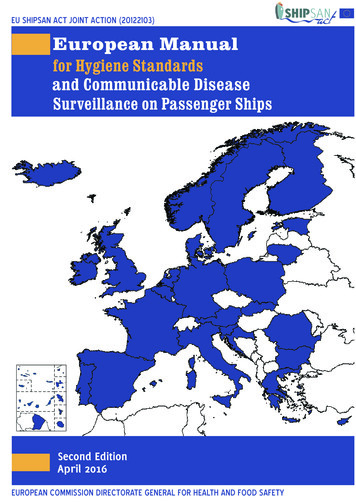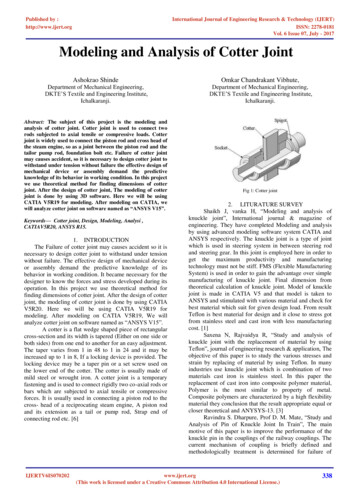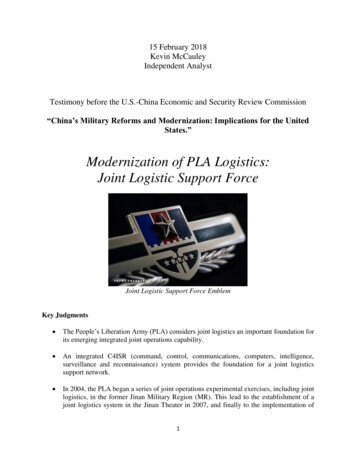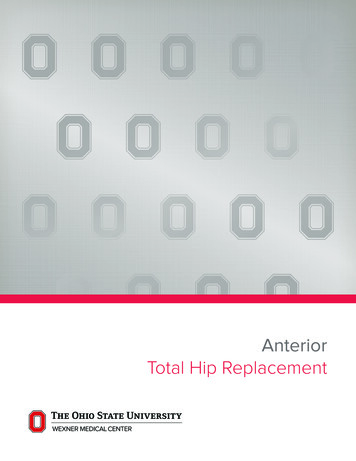
Transcription
EU SHIPSAN ACT JOINT ACTION (20122103)European Manualfor Hygiene Standardsand Communicable DiseaseSurveillance on Passenger ShipsSecond EditionApril 2016European Commission Directorate General for Health and Food Safety
European Manual for HygieneSurveillance on Passenger ShipsStandardsandCommunicableDiseaseEU SHIPSAN ACT joint actionSecond editionLarissa, April 2016Associated PartnersRegional Health Inspection, Burgas, BulgariaRegional Health Inspection, Varna, BulgariaRobert Koch-Institute, Berlin, GermanyInstitute for Occupational and Maritime Medicine, ZfAM, University Medical Center Hamburg-Eppendorf (UKE)and Ministry of Health and Consumer Protection, Hamburg, Germany in cooperation with the Hamburg PortHealth Center, HPHC, Institute for Hygiene and Environment, Hamburg, GermanyNational School of Public Health, Athens, GreeceLaboratory of Hygiene and Epidemiology, University of Thessaly, Larissa, GreeceDirectorate of Health, Reykjavik, IcelandHealth Service Executive, Naas, IrelandMinistry of Health, Rome, ItalyKlaipeda Public Health Centre, Klaipeda, LithuaniaNational Institute of Public Health, Instituto de Salud Carlos III, Madrid, SpainNational Institute of Public Health, Ljubljana, SloveniaPublic Health England, Chilton, United KingdomAssociation of Port Health Authorities, London, United KingdomCollaborating PartnersMinistry of Health, Vienna, AustriaFederal Public Service of Health, Food Chain Safety and Environment, Brussels, BelgiumMinistry of Health and Social Welfare, Directorate of Sanitary Inspection, Zagreb, CroatiaMinistry of Health, Public Health Services of the Medical and Public Health Services, Nicosia, CyprusCentre of Maritime Health and Society, University of Southern Denmark, DenmarkHealth Board, Health Care Department, Tallinn, EstoniaMinistry of Labour, Employment and Health, Paris, FranceEnvironmental Health Directorate, Port Health Services, MaltaNational Center for Hygiene and Safety (LCHV), National Institute for Health and the Environment (RIVM),Amsterdam, NetherlandsMunicipal Health Services Rotterdam, Rijnmond, NetherlandsNorwegian Directorate of Health, Oslo, NorwayMedical University of Gdansk, Interdepartmental Institute of Maritime and Tropical Medicine, Gdansk, PolandMinistry of Health, Lisbon, PortugalMinistry of Health - Department public health, Bucharest, RomaniaPublic Health Authority of the Ministry of Transport, Bratislava, SlovakiaMinistry of Health, social services and equality, Madrid, Spain
European Manual for Hygiene Standards on Passenger ShipsIIThis manual arises from the EU SHIPSAN TRAINET project which has received funding from the EuropeanUnion, in the framework of the Public Health Programme (2008-2013). The second edition of the manualarises from the EU SHIPSAN ACT Joint Action, which has received funding from the European Union, in theframework of the Health Programme (2008-2013). Sole responsibility lies with the authors and theConsumers, Health, Agriculture and Food Executive Agency (CHAFEA) is not responsible for any use that maybe made of the information contained therein.ISBN 978-960-99647-3-9
European Manual for Hygiene Standards on Passenger ShipsIIIAcknowledgmentsEU SHIPSAN ACT would like to acknowledge the following persons for their cooperative efforts in the revisionsof the G.B.E.J.L.M.A.J.P.A.J.J.P.Andersen, The Norwegian Institute of Public Health, NorwayAntoniadou, University of Thessaly, GreeceAtladottir, Centre for Health Security and Communicable Disease Prevention, IcelandBazargan, Cruise Lines International Association (CLIA) Europe, BelgiumBitsolas, University of Thessaly, GreeceBoehm, Crystal CruisesBoziaris, University of Thessaly, GreeceBroekhuijsen, National Center for Hygiene and Safety (LCHV), National Institute for Health and theEnvironment (RIVM), the NetherlandsBrown, Cruise Lines International Association (CLIA) GlobalBunyan, Carnival UK, United KingdomCalvert, Latis Scientific, United KingdomCassar, Environmental Health Directorate, Port Health Services, MaltaCooper, Association of Port Health Authorities, United KingdomDamman, Port of Zeebrugge, Gent, Ooostende, Nieuwport, BelgiumDávila Cornejo, Ministry of Health, SpainDel Valle, Cruise Lines International Association (CLIA) GlobalDietl, Carnival MaritimeDionisio, Directorate General for Health Prevention, ItalyDirksen-Fischer, Hamburg Port Health Center, Institute for Hygiene and Environment, Hamburg, GermanyDirven, The Norwegian Institute of Public Health, NorwayDiskin, Royal Caribbean International, Azamara Cruise Club, Celebrity CruisesDoherty, HSE Southern Area, IrelandDuarte Davidson, PHE Centre for Radiation, Chemical and Environmental Hazards, United KingdomGaulton, Public Health EnglandGeorgizas, National School of Public Health, GreeceGilsdorf, Robert Koch Institute, GermanyGuerra-Neira, Sanidad Exterior, SpainGunnarsson, Centre for Health Security and Communicable Disease Prevention, IcelandGutierrez-Alvarez, Royal Caribbean InternationalHadjichristodoulou, University of Thessaly, GreeceHadjipetris, Celestyal Cruises, GreeceHagger, RenovaTech International Consultancy, SpainHanson, Holland America LineIglesias, Ministry of Health, SpainJames, Windstar CruisesJansa, European Centre for Disease Prevention and Control, SwedenJohnson, National Board of Health and Welfare (Communicable Disease Prevention and Control), UnitedKingdomJong, European Centre for Disease Prevention and Control, SwedenKairiene, Klaipeda public health centre, LithuaniaKakakiou, Regional Union of South Aegean, GreeceKalkowski, Hamburg Port Health Center, Institute for Hygiene and Enviroment, Hamburg, GermanyKantonis, Ministry of Health, CyprusKatsaros, University of Thessaly, GreeceKokosharova, Regional Health Inspection, BulgariaKopilovic, Centre for Communicable Diseases National institute of public health, SloveniaKostara, University of Thessaly, GreeceKourea-Kremastinou, National School of Public Health, GreeceKourentis, University of Thessaly, GreeceKoutiva, University of Thessaly, GreeceKunchev, Ministry of Health, Section of Communicable Diseases Surveillance, Department of Public Health,BulgariaKutil, Carnival Corporation & plc, United States of AmericaLavruvianec, Klaipeda public health centre, LithuaniaLee, Pool Water Treatment Advisory Group, United KingdomLeonard, Holland America LineLepore, MSC Cruises
European Manual for Hygiene Standards on Passenger .I.M.A.E.P.J.A.C.E.T.N.D.N.C.R.H.L.D.M.IVMarshall, Royal Caribbean International & Celebrity CruisesMatic, MSC CruisesMcGarry, Cruise Lines International Association (CLIA) GlobalMenker, Menker — Laundry Management Consultants, GermanyMouchtouri, University of Thessaly, GreeceMulcahy, Health Service Executive, IrelandNichols, Health Protection Agency, Centre for Infectious Disease Surveillance and Control, United KingdomNiculescu, Port Constanta, RomaniaOtorepec, Centre for Communicable Diseases and Environmental Health, SloveniaPayne Hallstrom, European Centre for Disease Prevention and Control, SwedenPilipavicius, Klaipeda public health centre, LithuaniaPirnat, Centre for Communicable Diseases and Environmental Health, SloveniaRachiotis, University of Thessaly, GreeceRadic, Disney Cruise LineReusel, Antwerp Port Health Authority, BelgiumRiley, Pool Water Treatment Advisory Group, United KingdomRivas, Royal Caribbean International, Celebrity Cruises and Azamara Cruise ClubRobesyn, European Centre for Disease Prevention and Control, SwedenSauvee, Ministère des Affaires Sociales et de la Santé Département des Urgences Sanitaire, FranceSell, Color Line, NorwaySkipp, Carnival Corporation and plc, United KingdomSmith, Association of Port Health Authorities, United KingdomThomas, Public Health England, United KingdomTserkezou, University of Thessaly, GreeceTuelsner, Carnival MaritimeTzikou, Regional Union of South Aegean, GreeceVarela Martinez, Centro Nacional de Epidemiologia, SpainVerikouki, University of Thessaly, Greecevon Münster, Institute for Occupational and Maritime Medicine (ZfAM), Hamburg, GermanyVozelevskaja, Health Protection Service of Tallinn, EstoniaWagner, International & Strategic Coordination, Primary Health Care & Crisis Management, BelgiumWang, World Health Organization (WHO), FranceWebster, Disney Cruise LineWilkinson, Norwegian Cruise LineWinter, Robert Koch Institute, GermanyZamfir, Celestyal Cruises, GreeceZhao, Carnival Cruise LineEU SHIPSAN ACT would like to thank the advisory board for its contribution:J.P.D.C.C.Ames, Centers for Diseases Control and Prevention, Vessel Sanitation Program (VSP)Guglielmetti, Directorate General for Health and Food Safety (DG SANTE)Lins Menucci, World Health Organization (WHO)Menel-Lemos, Consumers, Health, Agriculture and Food Executive Agency (CHAFEA)Varela Santos, European Centre for Disease Prevention and Control (ECDC)The first edition of the manual was produced under work package 5 of the EU SHIPSAN TRAINET project andcan be downloaded from http://www.shipsan.eu/Home/EuropeanManual.aspx
European Manual for Hygiene Standards on Passenger CVPDVSPWHOWSPAutomatic Pump Shut-OffCritical Control PointClosed-Circuit TelevisionColony Forming UnitCritical LimitCruise Lines International AssociationChest X-RaysEuropean CommissionEuropean Cruise CouncilEuropean Centre for Disease Prevention and ControlEuropean Legionnaires’ Disease Surveillance NetworkEuropean Programme for Intervention Epidemiology TrainingEuropean UnionEuropean Union Member StatesEuropean Working Group on Legionella InfectionsEarly Warning and Response SystemFood and Agriculture OrganizationFeline CalicivirusFirst In — First OutGravity Drainage SystemGastrointestinal IllnessHazard Analysis and Critical Control PointHuman Normal ImmunoglobulinInternational Catering WasteInternational Health RegulationsInfluenza-Like IllnessInternational Labour OrganizationInternational Maritime Dangerous GoodsInternational Maritime OrganizationIntegrated Pest ManagementInternational Organization for StandardizationInternational Water AssociationLegal RequirementInternational Convention for the prevention of pollution from shipsMaritime Declaration of HealthMeasles-Mumps-RubellaMeasles-Mumps-Rubella and VaricellaNephelometric Turbidity UnitOutbreak Management PlanPort Health AuthorityPersonal Protective EquipmentPolyvinyl ChlorideQuaternary Ammonium CompoundRecreational Water FacilitiesSafety Of Life At SeaShip Sanitation Control CertificatesShip Sanitation Control Exemption CertificatesRecommended StandardSafety Vacuum Release SystemTravel-Associated Legionnaires’ DiseaseThermostatic Mixing ValveUltra VioletVolatile Organic CompoundsVaccine-Preventable DiseaseVessel Sanitation ProgramWorld Health OrganizationWater Safety PlanV
European Manual for Hygiene Standards on Passenger ShipsVITable of contentsi.ii.iii.iv.Introduction . 1Purpose and audience of the manual . 1Manual structure and format . 2Administrative procedures . 2Part A. 7Definitions . 81.Medical facilities . 212.Communicable disease surveillance . 253.Food safety. 313.1 Hazard Analysis and Critical Control Point . 313.2 Food handlers . 343.3 General requirements for food handling areas . 393.4 General food safety rules . 433.5 Equipment and utensils. 583.6 Cleaning, disinfection and storage of working utensils and equipment . 634.Potable water safety . 734.1 Water Safety Plan . 734.2 System assessment . 744.3 Operational monitoring . 824.4 Management Plan . 855.Recreational water safety . 896.Pest management. 1097.Housekeeping and facilities . 1137.1 Accommodation and public spaces . 1137.2 Toilets and hand washing facilities . 1167.3 Nursery and play areas . 1177.4 Hairdresser’s, beauty salons and gyms . 1207.5 Pet/animal housing areas . 1227.6 Laundry . 1238.Hazardous chemical agents . 1279.Waste management . 1319.1 All types of wastes. 1319.2 Garbage . 1339.3 Sewage and grey water . 1369.4 Hazardous waste . 1379.5 Medical waste . 13910. Ballast water management. 143Reference list — Part A . 145
European Manual for Hygiene Standards on Passenger ShipsPart BVII. 151Guideline I . 153Prevention and control of influenza-like illness on passenger ships . 153A. Guidelines for the prevention and control of seasonal influenza on passenger ships . 1541Pre-embarkation . 1542During the voyage . 1553Before disembarkation . 1604After disembarkation . 1615Competent authorities’ actions . 162B. Specific guidance during an influenza pandemic . 163Reference list . 165Guideline II . 167Prevention and control of gastroenteritis on passenger ships . 1671Overview . 1672How to differentiate gastroenteritis outbreaks . 1683Modes of transmission of gastrointestinal illness . 1694Activity plan . 1705Everyday preventive measures/actions . 1715.1 Level 0 Everyday preventive measures/actions by the ship . 1715.2 Level 0 Everyday preventative action by shipping companies . 1725.3 Level 1 Low-level gastroenteritis activity — action by the ship . 1736Level 2 Management of an outbreak. 1746.1 Level 2 Management of an outbreak — actions by the ship. 1746.2 Level 2 Outbreak actions by others (agencies and owners) . 1757Level 3 After the outbreak action . 1758Further guidance . 175Reference list . 177Guideline III . 179Prevention and control of legionellosis on passenger ships . 1791Overview . 1792Legionellosis disease prevention and control on ships . 1812.1 Every day preventive measures on board ships . 1812.2 Case/cluster/outbreak management . 1872.3 Port competent authority actions . 190Reference list . 191Guideline IV . 193Prevention and control of vaccine-preventable diseases on passenger ships; focusing onmeasles, rubella and varicella . 1931Overview . 1932Prevention of vaccine-preventable diseases . 1962.1 Pre-embarkation preventive measures . 196
European Manual for Hygiene Standards on Passenger ShipsVIII2.2 During voyage (every day) preventative measures . 1973Diagnosis of acute skin rash and surveillance . 1983.1 Clinical diagnosis . 1983.2 Laboratory diagnosis and confirmation . 1993.3 Surveillance. 2014Case and outbreak management on the ship . 2024.1 Immediate control measures . 2024.2 Supplementary control measures according to risk assessment . 2035Control measures by competent authorities and other stakeholders (agencies and owners) . 207Reference list . 208Annexes . 211Annex 1: Administrative issues . 212Annex 2: Hygiene inspection guidelines . 215Annex 3: Record keeping and training for crew included in the manual . 225Annex 4: Corrective action statement . 228Annex 5: Recommended medical facilities, medication and medical staff competency for passenger shipsmaking international voyages . 229Annex 6: Surveillance of communicable diseases on board ships. 231Annex 7: Gastrointestinal illness log (recommended log) . 232Annex 8: Influenza-like illness log (recommended log) . 233Annex 9: Example of gastrointestinal illness questionnaire . 234Annex 10: Model Maritime Declaration of Health (MDH) . 236Annex 11: Ship communication form . 238Annex 12: Communicable diseases surveillance routine recording form . 2 Annex 13: Identification of physical, chemical and microbiological hazards for food . 246Annex 14: Model training plan . 247Annex 15: Hand washing method . 250Annex 16: Guidance on development and use of WSPs . 251Annex 17: Suggested competences for the training of crew responsible for the WSP implementation . 259Annex 18: Parameters for water quality monitoring (Council Directive 98/83/EC and Council Directive2013/51/EURATOM) . 260Annex 19: Recommendations for flushing outlets . 263Annex 20: Recommended Faecal and Vomit Accident Release Plan for RWF . 264Annex 21: Rules for sampling and testing of water from recreational water facilities . 265Annex 22: Suggestions for corrective actions to be taken in case of water quality parameters out of limitsin recreational water facilities . 266Annex 23: Examples of health advisory signs for recreational water facilities . 267Annex 24: Requirements for the determination and assessment of risk of hazardous chemical agents[Council Directive 98/24/EC]. 268Annex 25: Background information for influenza . 270Annex 26: Model health questionnaires for screening persons before embarkation . 273Annex 27: Examples of informative leaflet for the pandemic A(H1N1) 2009 influenza virus . 275Annex 28: Example of calculating the ILI and GI threshold levels of an outbreak . 277Annex 29: Examples of preventive measures for gastroenteritis infections including norovirus . 279
European Manual for Hygiene Standards on Passenger ShipsIXAnnex 30: Example of hazard analysis in prevention of gastroenteritis transmission on board ship . 280Annex 31: Disinfectants . 281Annex 32: Cleaning and disinfection procedures for dealing with potentially contaminated surfaces . 283Annex 33: Suggested content of an Outbreak Management Plan (OMP) . 285Annex 34: Epidemiology of gastrointestinal illness on board passenger ships . 286Annex 35: Background information on Legionnaires’ disease and Legionella spp. . 287Annex 36: Chlorine disinfection procedures of water tanks and distribution system (EWGLI, 2011) . 289Annex 37: Thermal disinfection procedures of hot water tanks and distribution system (EWGLI, 2011)290Annex 38: Personal Protective Equipment . 292Annex 39: Legionnaires’ disease case investigation questionnaire . 293Annex 40: Sampling guidelines (EWGLI 2011). 296Annex 41: Contact tracing form. 300Annex 42: Case definitions for measles, rubella and varicella . 301Index . 304
European Manual for Hygiene Standards on Passenger Ships1i. IntroductionIn 2012, approximately 390 million passenger ferry trips were recorded through European ports andin 2013, 198 cruise ships were domiciled or participated in the European cruise ship market. Thenumber of passengers embarked on their cruises from a European port reached 6 million in 2013,out of which around 5 million were Europeans. A considerable proportion of the Europeanpopulation travels in modern ships, which are becoming more complex and are designed to carrymany more passengers and crew.Ships move continuously from one country to another where different standards of sanitation arerequired. These differences can cause administrative difficulties for competent authorities ofcountries, as well as for ship companies, when trying to deal with the prevention and control ofcommunicable diseases on board ships. Therefore, there is a need for standards regarding healthrelated issues, which can be adopted and accepted by all European Union Member States (EUMS).The EU SHIPSAN project (No A/790577) study revealed a d
and Ministry of Health and Consumer Protection, Hamburg, Germany in cooperation with the Hamburg Port Health Center, HPHC, Institute for Hygiene and Environment, Hamburg, Germany. National School of Public Health, Athens, Greece. Laboratory of Hygiene and Epidemiology, University of Thessaly, Larissa, . J. Ames, Centers for Diseases Control .










